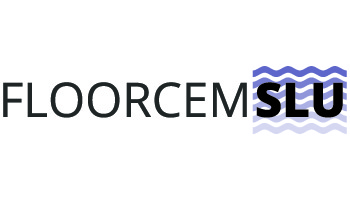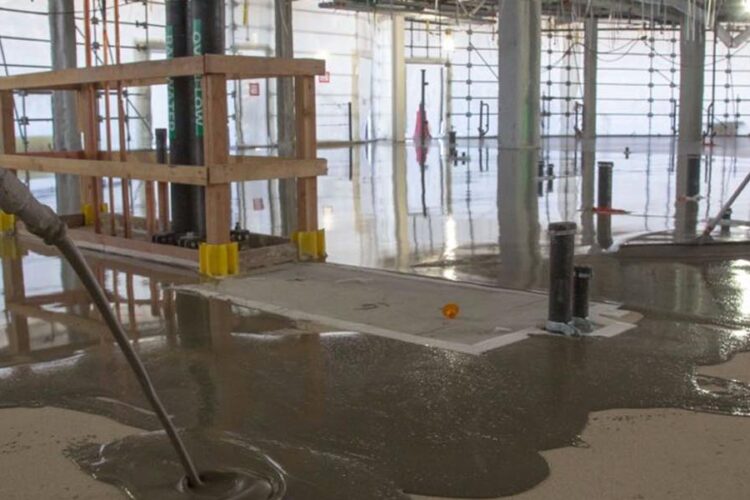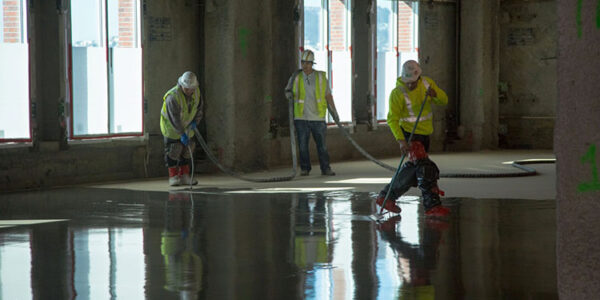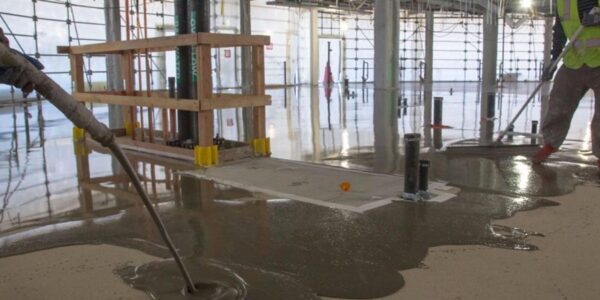
FloorCem SLU self-leveling is a proprietary dry blend of copolymers, cements and inorganic chemicals used to level floors prior to the installation of ceramic tile, natural stone tile, resilient flooring, carpet, wood and other floor coverings. FloorCem SLU’s ideal curing properties help eliminate installation problems such as bond failure, crumbling and staining of resilient flooring caused by the free moisture found in traditional underlayments.
FloorCem SLU self-leveling can be applied in one pour at a thickness of up to 1.5″ (3.8 cm) thick and seeks its own level in minutes. Formulated to achieve greater than 4000 psi compressive strength, this quick-setting underlayment can be used in residential structures with floor joists up to 24″ (61 cm) o.c.
- Portland based cast-underlayment
- Compatible with all flooring products
- Controls moisture when used with MES100 primer
- Install thickness of 1/8” to 1.5” in a single pour
- Manufacturer installed product
- Application rates of up to 40,000 square feet/ day

Installation Benefits
- Cures fast and develops high early-strength for quick installation
- Rated for extra-heavy use on concrete and wood subfloors with joists to 24″ (61 cm) per ASTM C627
- Can be applied from featheredge to 1.5″ (3.8 cm) thick in a single pour
- Reduces bond failure and crumbling of resilient flooring
Use As Underlayment For
|
Suitable Substrates
|
Package Specifications
Packaging: 50 lb (22.68 kg) Bags
Square Foot Coverage per 50 lb Bag (Square meter per
22.68 kg): 50 sq. ft. (4.6 M²) at 1/8″ (3 mm) thickness
Applicable Standards
- ASTM International (ASTM)
- ASTM C1708 Standard Test Methods for Self-leveling – Mortars Containing Hydraulic Cements
- ASTM C627 Standard Test Method for Evaluating Ceramic Floor Tile Installation Systems Using the Robinson-Type Floor Tester
- ASTM F1869 Standard Test Method for Measuring Moisture Vapor ASTM F710 Standard Practice for Preparing Concrete Floors to Receive Resilient Flooring
- American National Standards Institute (ANSI) ANSI A108.01 and A108.02 of the American National Standards for the Installation of Ceramic Tile
- Resilient Floor Covering Institute (RFCI) Recommended Work Practices for Removal of Resilient Floor Coverings
- Tile Council of North America (TCNA) TCNA Handbook for Ceramic Tile Installation, TCNA Method EJ171
Environmental Consideration
Use of this product may contribute towards LEED® credits.
Limitations
- Interior use only.
- Do not bond directly to hardwood, Luan plywood, particle board, parquet, cushion or sponge-back vinyl flooring, metal, fiberglass or plastic.
- Do not use as a permanent wear surface.
- Do not use on sloped surfaces that require drainage.
- Use precautions when applying over post-tensioned concrete, pre-stressed concrete or prefabricated concrete planks.
General Surface Prep
All surfaces must be structurally sound, clean, dry and free from contaminants that would prevent a good bond. Concrete must be fully cured. Refer to final flooring manufacturers requirements for maximum moisture vapor transmission limitations. Concrete surfaces should be primed with Floor Seal MES 100 (with sand broadcast) in areas with elevated moisture levels. For other substrates, including concrete with low moisture emission levels, CemPrime A – Acrylic Primer or CemPrime E – 100% Solids Epoxy Primer (with sand broadcast) may be used. Smooth concrete surfaces, existing glazed tile, terrazzo, or
polished stone may need to be roughened or scarified. For increased performance on floors, concrete surfaces must be mechanically profiled and prepared by shotblasting, sandblasting, water-jetting, scarifying, diamond-grinding or other approved methods (reference ICRI CSP 3 standards for acceptable profile height). Sheet vinyl must be well bonded and stripped of old finish.
Bonding to Concrete Surfaces
Concrete must be fully cured and must accept water penetration. Test by sprinkling water on various areas of the substrate. If water penetrates, then a good bond can be achieved. If water beads, surface contaminants are present, and loss of adhesion may occur. Contaminants should be mechanically removed before installation. Concrete must be free of efflorescence and not subject to moisture beyond floor covering manufacturers’ limits or hydrostatic pressure. Concrete slabs may have a broomed or brushed finish to enhance the bond. Smooth concrete slabs must be mechanically abraded to ensure a good bond unless a smooth non porous surface primer is used.
Bonding to Plywood Surfaces
Plywood floors, including those under resilient flooring, must be structurally sound and must meet all ANSI A108.01 Part 3.4 requirements. For questions about proper subfloor installation, call Floor Seal Technology. For a metal lath, fasten every 6″– 8″ (15–20 cm) with fasteners that have a galvanized or corrosion-resistant coating. For a 23/32″ (18.2 mm) plywood subfloor with 24″ (61 cm) o.c. joists, the metal lath must be a minimum of 2.5 lb/yd² (1.13 kg/M²).
Priming
Prime all surfaces with MES 100, CemPrime A – Acrylic Primer or CemPrime E – 100% Solids Epoxy Primer (with sand broadcast) before application.
Joints or Cracks in Substrate
Expansion joints and cold joints, as described in ANSI A108.01, should be carried from the substrate up through the tile or flooring surface and filled with an appropriate elastomeric sealant, such as Custom’s® 100% Silicone. For the proper treatment of control or saw cut joints and cracks for flooring, refer to ASTM F710.
Mixing Ratios – Powder to Water
Mix the entire 50 lb (22.68 kg) bag of powder with 5.25 – 5.75 quarts (5–5.4 L) of clean, cool water.
Mixing Procedures Barrel
Mix 50 lb (22.68 kg) bag of powder with the appropriate amount of clean, cool water. Slowly add powder to water while mixing with a heavyduty 1/2″ (13 mm) electric drill and an “eggbeater” mixing paddle at minimum 650 RPM. Thoroughly mix for 2 minutes to a lump-free consistency. Do not overmix. Overmixing or moving the mixer up and down during the mixing process could trap air, which could shorten the pot life or cause pinholing during application and curing.
Pumping
FloorCem SLU can be pumped with a mixing pump. Adjust the water setting to obtain the optimum workability. Do NOT overwater. Pump the mix and use spreader to evenly distribute the materials to desired thickness.
Application
Apply MES 100, CemPrime A – Acrylic Primer, LevelQuik® Latex Primer or CemPrime E – 100% Solids Epoxy Primer (with sand broadcast) according to the specifications in the respective technical data sheet for each product. Pour or pump FloorCem SLU self-leveling, then spread with a long-handled gauged spreader. Will seek its own level during the first 20 minutes. For featheredging and touch-ups, use a smoothing tool. Can be applied up to 1.5″ (3.8 cm) thick in one application. If a second layer is required, install immediately after the first layer has set to a walkable hardness. If the first layer has dried over 12 hours, re-prime before second application. Dries to a walkable hardness in 2–4 hours. For pumping and large scale applications, contact Floor Seal Technology for more information.
Curing
Install moisture insensitive ceramic tile and stone in four hours; all other floor coverings should be installed after 16 hours. Drying time can vary with temperature and humidity.
Cleaning of Equipment
Clean with water before material dries.
Health Precautions
This product contains Portland cement. Avoid eye contact or prolonged contact with skin. Wash thoroughly after handling. If eye contact occurs, flush with water for 15 minutes and consult a physician. Use with adequate ventilation; do not breathe dust and wear a NIOSH approved respirator. If ingested, do not induce vomiting; call a physician immediately.
Conformance to Building Codes
Installation must comply with the requirements of all applicable local, state and federal code jurisdictions.
Product Maintenance
Properly installed product requires no special maintenance.
Warranty
Floor Seal Technology warrants to the original consumer purchaser that its product shall be free from defects in material and workmanship under normal and proper usage for a period of one year following the date of original purchase. When used in conjunction with MES 100 concrete moisture control system, warranty term will match that of the MES 100 system. Floor Seal Technology’s sole liability under this warranty shall be limited to the replacement of the product. Some states, countries or territories do not allow the exclusion or limitation of incidental or consequential damages, so the above limitation or exclusion may not apply to you. This warranty will not extend to any product which has been modified in any way or which has not been used in accordance with Floor Seal Technology’s printed instructions. Floor Seal Technology makes no other warranties either expressed or implied. This warranty provides specific legal rights; other rights may vary from state to state or from one country/territory to another.
Resources
Below you can view and download our available documents for more information about FloorCem SLU.



